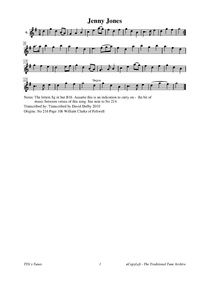Template:Pagina principale/Vetrina: Difference between revisions
No edit summary |
No edit summary |
||
| Line 1: | Line 1: | ||
{{SheetMusic | {{SheetMusic | ||
|f_track= | |f_track=Cader Idris.mp3 | ||
|f_pdf= | |f_pdf=Caret Idris.pdf | ||
|f_artwork= | |f_artwork=JohnParry.png | ||
|f_tune_name= | |f_tune_name=Sweet Jenny Jones | ||
|f_track_title= | |f_track_title=Sweet Jenny Jones | ||
|f_section=abc | |f_section=abc | ||
|f_played_by=[https://soundcloud.com/ | |f_played_by=[https://soundcloud.com/andrewcampling Andrew Campling] | ||
|f_notes= | |f_notes=Photo of John Parry, c. 1825 - commonly known by his bardic name Bardd Alaw | ||
|f_caption= | |f_caption=Parry did much to promote and popularize Welsh music in England in both music hall and fashionable society settings, and he was very successful with this air which was immensely popular in 19th century England. | ||
|f_source=[https://soundcloud.com/ | |f_source=[https://soundcloud.com/andrewcampling/cader-idris Soundcloud] | ||
|f_pix=420 | |f_pix=420 | ||
|f_picpix=200 | |f_picpix=200 | ||
|f_article=[[ | |f_article=[[Sweet Jenny Jones | '''Sweet Jenny Jones''']] | ||
The Jenny Jones of the title was said to have been a dairymaid at Pontblyddin Farm, who fell in love with a ploughman named Edward Morgan. Edward went to sea and spent twenty years in the Navy, however, he returned to marry Jenny. | |||
The story entranced actor Charles James Mathews, who visited Wales around 1825 and actually met the Morgans and heard their story first-hand. During his trip he heard a harper play Parry’s melody in the hotel he was staying at in Llangollen, and memorized it, not knowing who composed it. | |||
He was inspired to write a song about the Morgans to the melody, called “Song of Jenny Jones and Ned Morgan,” and performed it for friends in London when he returned. At the end of the evening’s entertainment an elderly gentleman approached him and claimed it was he who originally wrote the tune. | |||
It was called “Cader Idris,” the old man—Bardd Alaw himself—said, and it had won him a prize at the 1804 Eisteddfod. Mathews continued to perform the song which caught on immediately. It struck a romantic chord, and was popular for nearly two decades, enough to generate other ‘Jenny Jones’ songs and parodies. | |||
Figures of Jenny Jones were fashioned in chinaware, horse-brasses, and other items. | |||
}} | }} | ||
Revision as of 15:44, 9 February 2024

Played by: Andrew Campling
Source: Soundcloud
Image: Photo of John Parry, c. 1825 - commonly known by his bardic name Bardd Alaw

The Jenny Jones of the title was said to have been a dairymaid at Pontblyddin Farm, who fell in love with a ploughman named Edward Morgan. Edward went to sea and spent twenty years in the Navy, however, he returned to marry Jenny.
The story entranced actor Charles James Mathews, who visited Wales around 1825 and actually met the Morgans and heard their story first-hand. During his trip he heard a harper play Parry’s melody in the hotel he was staying at in Llangollen, and memorized it, not knowing who composed it.
He was inspired to write a song about the Morgans to the melody, called “Song of Jenny Jones and Ned Morgan,” and performed it for friends in London when he returned. At the end of the evening’s entertainment an elderly gentleman approached him and claimed it was he who originally wrote the tune.
It was called “Cader Idris,” the old man—Bardd Alaw himself—said, and it had won him a prize at the 1804 Eisteddfod. Mathews continued to perform the song which caught on immediately. It struck a romantic chord, and was popular for nearly two decades, enough to generate other ‘Jenny Jones’ songs and parodies.
Figures of Jenny Jones were fashioned in chinaware, horse-brasses, and other items.
...more at: Sweet Jenny Jones - full Score(s) and Annotations
X:123 T:Jenny Jones M:3/4 L:1/8 R:Waltz S:Kerr - Merry Melodies, vol. 3, No. 307 (c. 1880's) Z:AK/Fiddler's Companion K:G V:1 clef=treble name="123." [V:1] d2 | g2d2B2 | G3AB2 | c2e2a2 | f2d2(ef) | g2d2B2 | c3de2 | d2g2f2 | g4d2 | g2d2B2 | G3AB2 | c2e2a2 | f2d2(ef) | g2d2B2 | c3de2 | d2g2f2 | g2z2 || g2 | b2g2b2 | a2f2a2 | g2e2a2 | f2d2g2 | b2g2b2 | a2f2a2 | g2f2e2 | d2e2f2 | g2d2B2 | G3AB2 | c2e2a2 | f2d2(ef) | g2d2B2 | c3de2 | d2g2f2 | g2z2 ||
